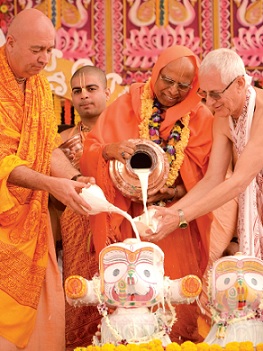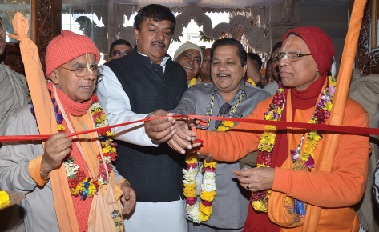
A grand temple opens in Noida, one of New Delhi’s important satellite cities.
After one crosses the Yamuna River from Delhi, India’s overcrowded capital city, the sight of Noida, a large satellite city in the National Capital Region, creates a welcoming impression. Since 1970, eight hundred thousand people have moved to Noida (short for New Okhla Industrial Development Authority) to take advantage of its wide roads, expansive residential townships, successful economy, excellent infrastructure, and emergence as a major hub for outsourcing and education. Naturally devotees in the International Society for Krishna Consciousness saw an opportunity to build and sustain a congregation here, and their vision proved to be true. Devotees opened a small center here in 1998. Over time, the congregation of families, working youths, and college students grew, as did the need for a suitable temple. Following almost eight years of planning and development, the temple opened on February 12, 2014, with the installation of deities of Radha-Govinda, Gaura-Nitai (Caitanya and Nityananda), and Jagannatha, Baladeva, and Subhadra.
Situated on a main boulevard and adjacent to Krishna Jayanti Park (owned by the government, maintained by ISKCON), the temple is highly accessible and visible. As modern and progressive as the city it overlooks, still it represents the Caitanya Vaisnava tradition. On either side of the front of the temple are giant reliefs of Sri Caitanya and Nityananda, and the temple opened on the anniversary of Lord Nityananda’s appearance.

Lord Krishna speaks the Bhagavad Gita to Arjuna
ISKCON Establishes Itself
The plot ISKCON secured is small, so the strategy was to “go vertical” to accommodate all of a temple’s typical elements. Topping the seven stories is a sixty-foot spire, its tip 130 feet from the ground.
In the mid 1970s Srila Prabhupada supervised the design of the first full-fledged ISKCON temple in a major Indian city, in Mumbai (Juhu). The Noida temple follows a similar model, with a large temple room, an auditorium, an adjoining guesthouse, a restaurant, a hall for weddings and birthday celebrations, a floor for education, and a kitchen and bedrooms in a residential wing. The temple, shops, offices, and hall are ready for use.

The stone fasade, with balconies, is similar to Srila Rupa Gosvami’s sixteenth-century Radha-Govinda temple in Vrindavan. The fasade and the interior also feature handcarved stone peacocks, elephants, a hundred intricate pillars, jalis (latticework), jharokhas (balconies), and chhatris (domed pavilions).
A Boon for Outreach
The new temple will increase and improve ISKCON Noida’s outreach, festival planning, and congregational development. The building will include the Bhaktivedanta Academy, ensuring that education will be easily available to the congregation. The Academy will have five classrooms, administration space, two large seminar halls, a play school for young children, and a library where visitors can sit at computers to read e-books or download lectures and kirtanas.

A dedicated,well-organized team of devotees prepared and served the Lord’s prasadam to thousands of guests
Srila Prabhupada wanted ISKCON temples to be places of education, and the Noida temple already offers courses in partnership with the Vrindavan Institute for Higher Education, organized by devotees at ISKCON’s Krishna -Balarama temple in Vrindavan. A commercial center being built a few blocks away will give devotees quick access to many people, improving the opportunity to attract the spiritually inclined to true higher education.
The Temple Courtyard
On a visit to the temple, at the entrance you see an elevated platform holding a nearly life-sized sculpture of Krishna and Arjuna on a chariot. The temple’s planners chose this scene because Krishna and Arjuna’s conversation, Bhagavadgita, epitomizes spiritual education. Because Lord Krishna ’s temple is a replica of the spiritual world, at the foot of the staircases on either side of the entrance stand the traditional statues of Jaya and Vijaya, doorkeepers in the spiritual world. A statue at the entrance honors the cow, favored by Lord Krishna (the transcendental cowherd boy), and one of humanity’s mothers because she provides us milk. Inside the temple’s balcony window you see Garu∂a, the Supreme Lord’s eternal winged carrier, ready to carry Him anywhere He desires.
Sri Sri Radha-Govinda Preside
A skilled craftsman carved the beautiful white-marble form of Radha and the black-marble form of Govinda, following directions given in the Vedic scriptures. The scriptures and the Vaisnava tradition teach us that the duly installed deity is in fact an incarnation of the Lord, known as arca-avatara (“incarnation for worship”). The Lord appears as the deity in the temple to accept the worship of His devotees.
 “The spiritual master’s duty,” Srila Prabhupada said, “is to engage the disciples in deity worship. In all our centers we have the method of deity worship: to dress the deity very nicely, to cleanse the temple very nicely, to offer nice foodstuffs to the deity and accept the remnants of the Lord’s foodstuff as our food.”
“The spiritual master’s duty,” Srila Prabhupada said, “is to engage the disciples in deity worship. In all our centers we have the method of deity worship: to dress the deity very nicely, to cleanse the temple very nicely, to offer nice foodstuffs to the deity and accept the remnants of the Lord’s foodstuff as our food.”

Following the tradition of Caitanya Vaisnavism, as well as Srila Prabhupada’s general practice, devotees at ISKCON Noida worship two other sets of deities besides Radha-Govinda: Gaura- Nitai, and Jagannatha, Baladeva, and Subhadra.
The Special Moment Behind the temple a huge tent on an empty lot served as the site for the sacred installation, which started Tuesday evening and concluded with the temple’s official inauguration on Thursday. As the elaborate ritual was about to begin, thousands anxiously awaited their first viewing of the deities, hidden onstage behind curtains. Finally the curtains opened, and the moment surely captured everyone’s heart eternally. As if a flood of light engulfed the tent, the deities’ radiant beauty poured forth and the devotees roared with delight and amazement.
From the few who could speak came shouts of “Haribol!” “Srimati Radharani stole the show!” and “Wow! So incredibly beautiful!”
It was apparent to everyone that these deities were not concealing their beauty at all. At that moment we could also truly appreciate the extraordinary skill and artistic flair of the craftsmen.
As prescribed, the deities had their eyes covered with cloth when the curtains opened during the Tuesday-evening ceremony. After some rituals, the netronmilan (“eye opening”) was held, and they opened their eyes for the first time, mercifully gazing upon the worshipers, who received great spiritual benefit. The Vedic scriptures tell us that whoever witnesses a deity installation is most blessed, and this was surely a moment of mercy.
 The last item on Tuesday evening was sayana adhivasa, when the deities lie down in beautiful beds to rest for the night. This is a one-time occurrence, because after the fullsize deities are installed on their altars, only the smaller deities are bathed and put into beds daily.
The last item on Tuesday evening was sayana adhivasa, when the deities lie down in beautiful beds to rest for the night. This is a one-time occurrence, because after the fullsize deities are installed on their altars, only the smaller deities are bathed and put into beds daily.
Behind where the deities had been standing throughout the evening, a large bedroom had been set up. When all the other rites for the evening were over, all the stage items had been removed, and most of the crowd had dispersed, a peaceful atmosphere reigned in the tent. In that quietude the sayana adhivasa was performed. In the bedroom were night lamps, fragrant flowers, mosquito nets, and soft, melodious chanting of mantras in praise of the Lord. The privileged few witnessing the ceremony included some of the ISKCON leaders and members of the congregation. The experience left a deep spiritual impression on our hearts.
On Wednesday, leading devotees continuted the auspicious installation rites with fervor and enthusiasm while others brought forth offerings to please the deities.
An extraordinary shower of the colors of nature’s beauty concluded the bathing ceremony, as flower petals of every color of the rainbow showered upon the deities and accentuated their beauty.
 During the deities’ two-hour procession from the tent to the temple, a helicopter circled repeatedly and poured colorful flowers on the deities and the temple spire. After discharging one load of flowers, the helicopter would land, reload with flowers, and fly again. “Helicopter Showers Flowers on ISKCON Deities” read one newspaper headline.
During the deities’ two-hour procession from the tent to the temple, a helicopter circled repeatedly and poured colorful flowers on the deities and the temple spire. After discharging one load of flowers, the helicopter would land, reload with flowers, and fly again. “Helicopter Showers Flowers on ISKCON Deities” read one newspaper headline.
Official Opening
The temple officially opened to the public on the third day of the festival. Cabinet Minister Ujjwal Raman Singh cut the ceremonial ribbon and offered puja to the deities. Twentyfive thousand Noida residents streamed in.
Srila Prabhupada’s followers have placed a new religious landmark in Uttar Pradesh. The temple is a magnificent monument to celebrate the glorious beauty of Their Lordships, and it will attract devotees for hundreds of years to come.
Lokanath Swami, a member of ISKCON’s Governing Body Commission as a GBC minister, serves as the zonal secretary for Noida. He oversaw the temple construction and presided over the installation ceremonies and the opening festivities.
